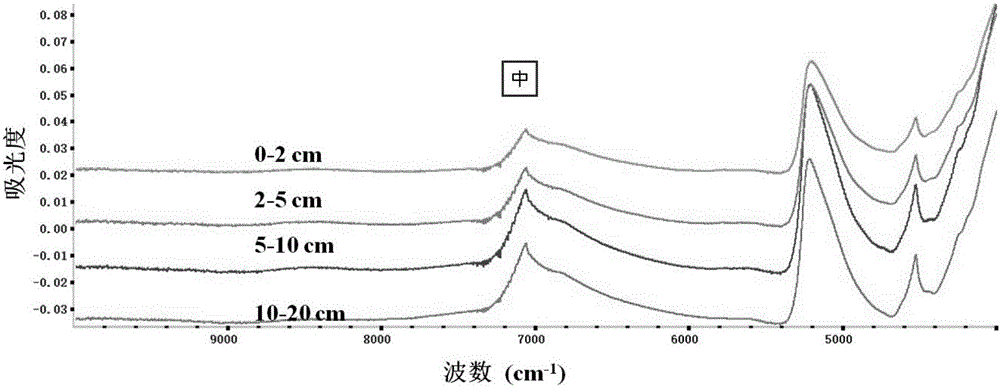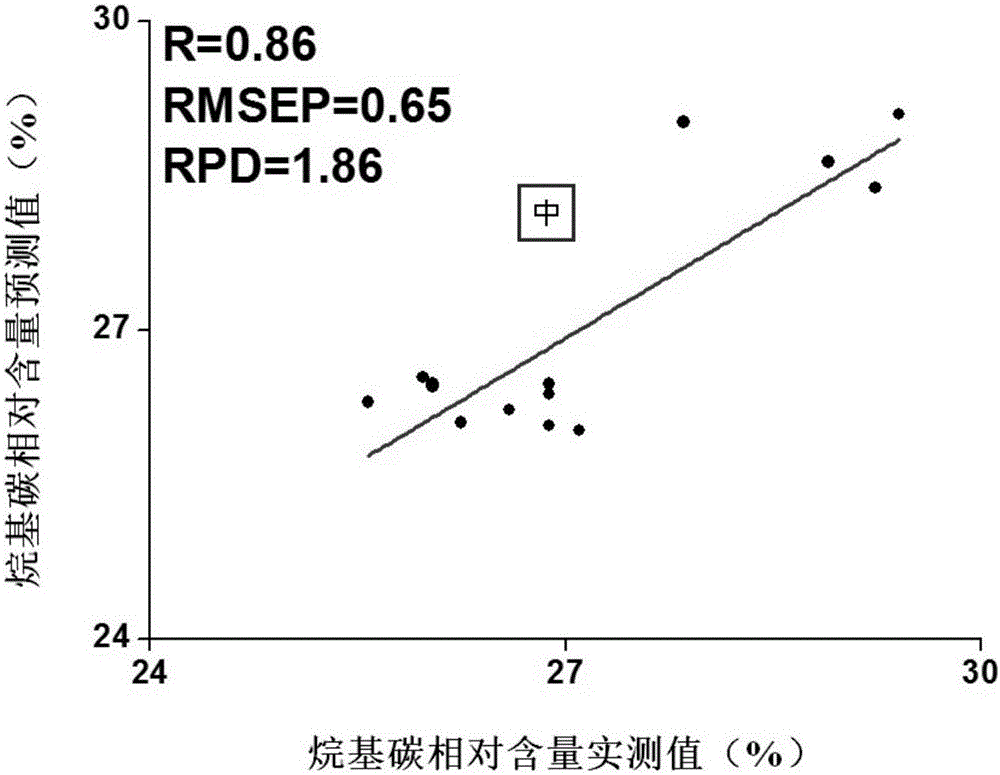Method for detecting organic components of soil by utilizing near infrared spectrum
A near-infrared spectroscopy and soil technology, which is applied in the field of detecting the chemical composition of soil organic matter, can solve the problems of special operation, expensive equipment, and high technical requirements, and achieve the effects of strong popularity, simple operation, and wide application range
- Summary
- Abstract
- Description
- Claims
- Application Information
AI Technical Summary
Problems solved by technology
Method used
Image
Examples
Embodiment 1
[0063] Prediction of Alkyl Carbon Relative Content in Example 1 Soil Organic Matter
[0064] (1) Prepare the soil sample to be tested. Remove impurities from the mineral layer soil, air-dry, pulverize, pass through a 60-mesh sieve, and store in a desiccator for future use. A total of 56 samples came from different depths (0-2, 2-5, 5-10, 0-2, 2-5, 5-10, 10-20cm) of soil samples.
[0065] (2) Using CP-MAS 13 The relative content of alkyl carbon in soil organic matter was measured by CNMR method. The soil samples were first pretreated with a hydrofluoric acid solution to remove some of the paramagnetic minerals and concentrate the organic matter. Soil samples treated with hydrofluoric acid were 13 C Solid state NMR analysis. The peaks in 0-50ppm on the NMR spectrum can be attributed to the alkyl carbon in SOM. After spectral processing such as phase correction and baseline correction, this band is integrated, and then the relative content of alkyl carbon in SOM can be obt...
Embodiment 2
[0075] Prediction of relative content of alkoxycarbon in embodiment 2 soil organic matter
[0076] (1) Prepare the soil sample to be tested. Remove impurities from the mineral layer soil, air-dry, pulverize, pass through a 60-mesh sieve, and store in a desiccator for future use. A total of 56 samples came from different depths (0-2, 2-5, 5-10, 0-2, 2-5, 5-10, 10-20cm) of soil samples.
[0077] (2) Using CP-MAS 13 The relative content of alkoxycarbons in soil organic matter was measured by CNMR method. The soil samples were first pretreated with a hydrofluoric acid solution to remove some of the paramagnetic minerals and concentrate the organic matter. Soil samples treated with hydrofluoric acid were 13 C Solid state NMR analysis. The spectral peaks in 50-110ppm on the nuclear magnetic spectrum can be attributed to the alkoxycarbons in SOM. After spectrogram processing such as phase correction and baseline correction, this band is integrated, and then the relative conten...
Embodiment 3
[0085] Example 3 Prediction of Relative Aromatic Carbon Content in Soil Organic Matter
[0086] (1) Prepare the soil sample to be tested. Remove impurities from the mineral layer soil, air-dry, pulverize, pass through a 60-mesh sieve, and store in a desiccator for future use. A total of 56 samples came from different depths (0-2, 2-5, 5-10, 0-2, 2-5, 5-10, 10-20cm) of soil samples.
[0087] (2) Using CP-MAS 13 The relative content of aromatic carbon in soil organic matter was measured by CNMR method. The soil samples were first pretreated with a hydrofluoric acid solution to remove some of the paramagnetic minerals and concentrate the organic matter. Soil samples treated with hydrofluoric acid were 13 C Solid state NMR analysis. The spectral peaks at 110-160ppm on the NMR spectrum can be attributed to the aromatic carbon in SOM. After spectrogram processing such as phase correction and baseline correction, this band is integrated, and then the relative content of aromat...
PUM
 Login to View More
Login to View More Abstract
Description
Claims
Application Information
 Login to View More
Login to View More - R&D
- Intellectual Property
- Life Sciences
- Materials
- Tech Scout
- Unparalleled Data Quality
- Higher Quality Content
- 60% Fewer Hallucinations
Browse by: Latest US Patents, China's latest patents, Technical Efficacy Thesaurus, Application Domain, Technology Topic, Popular Technical Reports.
© 2025 PatSnap. All rights reserved.Legal|Privacy policy|Modern Slavery Act Transparency Statement|Sitemap|About US| Contact US: help@patsnap.com



